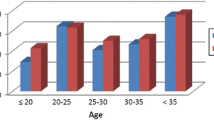Abstract
Background
To assess the myopic corneal diameter with Orbscan II Topography System (Bausch & Lomb, Orbtek Inc., Salt Lake City, UT, USA).
Methods
Four hundred sixty-two eyes of 231 myopic patients and 129 emmetropic eyes were measured with the Orbscan II system. Eyes were divided into four groups according to the spherical equivalent(SE) as follows: group 1 [emmetropic group, spherical equivalents between −0.50 D and +0.50 D (−0.50<SE ≤ +0.50)]; group 2 [low myopia group, spherical equivalent between −0.50 D and −3.00D (−3.00<SE ≤ −0.50)]; group 3 [median myopia group, spherical equivalent between −3.00 and −6.00D (−6.00<SE ≤ −3.00)]; and group 4 [high myopia group, spherical equivalents of −6.00D or less (≤−6.00)]. Manifest refraction results and the Orbscan II corneal topographic maps were reviewed retrospectively. Horizontal corneal diameters (white-to-white [WTW] distance) were measured with the Orbscan II system. Subjects in different groups were matched to be comparable in terms of spherical equivalents.
Results
The corneal diameter in all myopic eyes was 11.49 ± 0.36 mm. There were no significant differences between right and left eyes in the t-test for paired samples (t = -0.119, P = 0.906). Differences among four groups proved to be significant in the ANOVA (F = 4.487, P = 0.004).
Conclusions
This article provides a detailed description and analysis of Orbscan II corneal diameter of a normal myopic population. High degree of mirror image symmetry existed in myopic corneal diameter. Spherical equivalents made a difference in corneal diameter.


Similar content being viewed by others
Reference
Hoffer KJ (2000) Clinical results using the Holladay 2 intraocular lens power formula. J Cataract Refract Surg 26:1233–1237
Werner L, Izak AM, Pandey SK, Apple DJ, Trivedi RH, Schmidbauer JM (2004) Correlation between different measurements within the eye relative to phakic intraocular lens implantation. J Cataract Refract Surg 30:1982–1988
Seo JH, Kim MK, Wee WR, Lee JH (2009) Effects of white-to-white diameter and anterior chamber depth on implantable collamer lens vault and visual outcome. J Refract Surg 25(8):730–738
Kohnen T, Thomala MC, Cichocki M, Strenger A (2006) Internal anterior chamber diameter using optical coherence tomography compared with white-to-white distances using automated measurements. J Cataract Refract Surg 32(11):1809–1813
Kawamorita T, Uozato H, Kamiya K, Shimizu K (2010) Relationship between ciliary sulcus diameter and anterior chamber diameter and corneal diameter. J Cataract Refract Surg 36(4):617–624
Müller A, Doughty MJ (2002) Assessments of corneal endothelial cell density in growing children and its relationship to horizontal corneal diameter. Optom Vis Sci 79(12):762–770
Seet B, Wong TY, Tan DT, Saw SM, Balakrishnan V, Lee LK, Lim AS (2001) Myopia in Singapore: taking a public health approach. Br J Ophthalmol 85(5):521–526
Edwards MH, Lam CS (2004) The epidemiology of myopia in Hong Kong. Ann Acad Med Singap 33(1):34–38
Wang L, Auffarth GU (2002) White-to-white corneal diameter measurements using the Eyemetrics Program of the Orbscan topography system. Dev Ophthalmol 34:141–146
Baumeister M, Terzi E, Ekici Y, Kohnen T (2004) Comparison of manual and automated methods to determine horizontal corneal diameter. J Cataract Refract Surg 30(2):374–380
Khng C, Osher RH (2008) Evaluation of the relationship between corneal diameter and lens diameter. J Cataract Refract Surg 34(3):475–479
Alfonso JF, Ferrer-Blasco T, González-Méijome JM, García-Manjarres M, Peixoto-de-Matos SC, Montés-Micó R (2010) Pupil size, white-to-white corneal diameter, and anterior chamber depth in patients with myopia. J Refract Surg 26(11):891–898
Srivannaboon S, Chotikavanich S (2005) Corneal characteristics in myopic patients. J Med Assoc Thail 88(9):1222–1227
Wei RH, Lim L, Chan WK, Tan DT (2006) Evaluation of Orbscan II corneal topography in individuals with myopia. Ophthalmology 113(2):177–183
Riordan-Eva P (2001) Anatomy & embryology of the eye. In: Vaughan D, Asbury T (eds) General ophthalmology. McGraw-Hill Lange, New York, pp 8-10
Starck T, Hersh PS (2000) Corneal dysgenesis, dystrophies, and degenerations. In: Abelson MB, Albert DM, Azar DT (eds) Principles and practice of ophthalmology, 2nd ed. W B Saunders, Philadelphia, pp 695–696, 3618–3619
Duke-Elder S, Wybar KC (1961) The cornea. In: Duke-Elder S (ed) System of ophthalmology. The anatomy of the visual system. Henry Kimpton, London, pp 92–94
Zhang H (2005) Eye anatomy. In: Fengming L (ed) Chinese ophthalmology. People’s Medical Publishing House, Beijing, pp 89–90
Hashemi H, KhabazKhoob M, Yazdani K, Mehravaran S, Mohammad K, Fotouhi A (2010) White-to-white corneal diameter in the Tehran Eye Study. Cornea 29(1):9–12
Rüfer F, Schröder A, Erb C (2005) White-to-white corneal diameter: normal values in healthy humans obtained with the Orbscan II topography system. Cornea 24(3):259–261
Financial support
None
No conflicting relationship exists for any author.
Author information
Authors and Affiliations
Corresponding author
Additional information
The authors have full control of all primary data, and they agree to allow Graefe’s Archive for Clinical and Experimental Ophthalmology to review their data if requested.
Rights and permissions
About this article
Cite this article
Zha, Y., Feng, W., Han, X. et al. Evaluation of myopic corneal diameter with the Orbscan II Topography System. Graefes Arch Clin Exp Ophthalmol 251, 537–541 (2013). https://doi.org/10.1007/s00417-012-2069-6
Received:
Revised:
Accepted:
Published:
Issue Date:
DOI: https://doi.org/10.1007/s00417-012-2069-6




